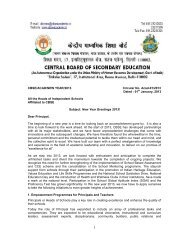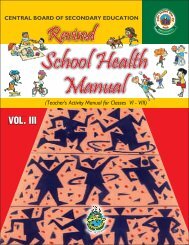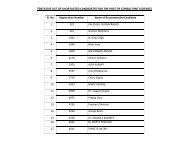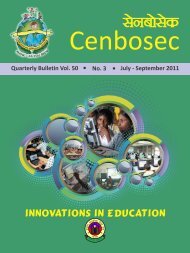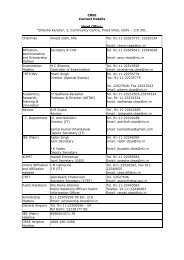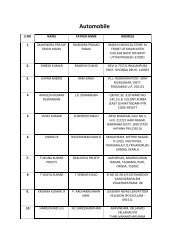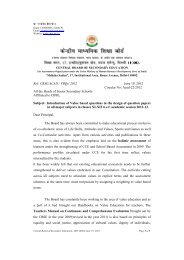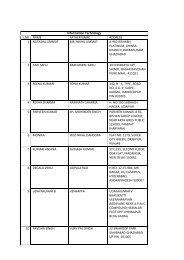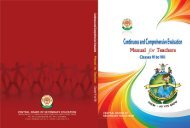Promoting Healthy food habits amongst Students - CBSE
Promoting Healthy food habits amongst Students - CBSE
Promoting Healthy food habits amongst Students - CBSE
You also want an ePaper? Increase the reach of your titles
YUMPU automatically turns print PDFs into web optimized ePapers that Google loves.
~ 2 ~<br />
Further, tobacco consumption <strong>amongst</strong> adolescent population is also another major disturbing issue and is one of the<br />
most important risk factor for much of the morbidity and mortality and increase in diet related chronic noncommunicable<br />
disorders.<br />
In order to address this issue, the Board expects the schools to follow the following guidelines for ensuring ‘Tobacco<br />
free Schools’:<br />
1. Display sign boards stating “Tobacco Free School” or “Tobacco Free Institution” at prominent places on the<br />
boundary wall outside the main entrance.<br />
2. No sale of tobacco products inside the premises and within the radius of 100 yards from School/ Educational<br />
Institutions and mandatory signage in this regard to be displayed prominently near the main gate and on boundary<br />
wall of School/ Institution.<br />
3. No smoking or chewing of tobacco inside the premises of institution by students/ teachers/ other staff members/<br />
visitors.<br />
4. Display of sign boards “No Smoking Area- Smoking here is an offence” of 60x30cm size inside the institution (as<br />
mandated by law).<br />
5. Posters with information about the harmful effects of tobacco should be displayed at prominent places in the<br />
school/ institutions. <strong>Students</strong> should be encouraged to make their own posters on tobacco control themes.<br />
6. A copy of the Cigarette and other Tobacco Products Act (COTPA) 2003 needs to be available with the Principal/<br />
Head of School/ Institution. (It can be downloaded from the website of the Ministry of Health & Family Welfare –<br />
www.mohfw.nic.in)<br />
7. A “Tobacco Control Committee” needs to be in place. It may be chaired by Principal/ Head of School/ Institution,<br />
with members comprising of a science teacher, or any other teachers, school counselor (if available), at least two<br />
NSS/ NCC/ Scout students, at least two parents representatives, area MLA, area SHO, Municipal Councilor,<br />
Member of PRIs, any other member. The committee shall monitor the tobacco control initiatives of the school/<br />
institute. The committee shall meet quarterly and report to the district administration.<br />
8. Integrate tobacco control activities with the ongoing School Health Programme and Health and Wellness Clubs.<br />
9. Awareness regarding the hazardous effects of passive smoking needs to be created among the students and this<br />
may also be a part of the Parental Awareness Programmes.<br />
10. Promote writing of Anti–tobacco slogans on the School/ Institute stationery.<br />
11. The Principal/ Head of School/ Institute shall recognize tobacco control initiatives by students/ teachers/ other staff<br />
and certificates of appreciation or awards may be given.<br />
12. Regular vigilance against smoking at home and school needs to be emphasized. The matter can be discussed in<br />
PTA meetings with parents.<br />
13. Awareness on recent laws enacted on prohibition of Tobacco products in public places needs to be created among<br />
students.<br />
14. Project work on Substance/ Tobacco abuse may be assigned to students as part of school assignment across<br />
disciplines and `No Tobacco Week’ may be celebrated in school.<br />
Each year, 26 th June is observed as the International Day against Drug Abuse and Illicit Trafficking. On this occasion<br />
Board expects schools to renew their resolve to fight this menace collectively by organizing awareness campaigns,<br />
conducting seminars and workshops and holding cultural Programmes and exhibitions etc.<br />
The conflicting role models thrown up by the social context as well as the explosion of media often result in giving out<br />
ambiguous signals to young minds. It thus becomes even more mandatory that the schools serve as agents of change<br />
and transformation by bringing out the best from within each child.<br />
Looking forward to your whole hearted cooperation<br />
With best wishes and regards,<br />
Yours sincerely,<br />
Dr. Sadhana Parashar<br />
Director (Training)





